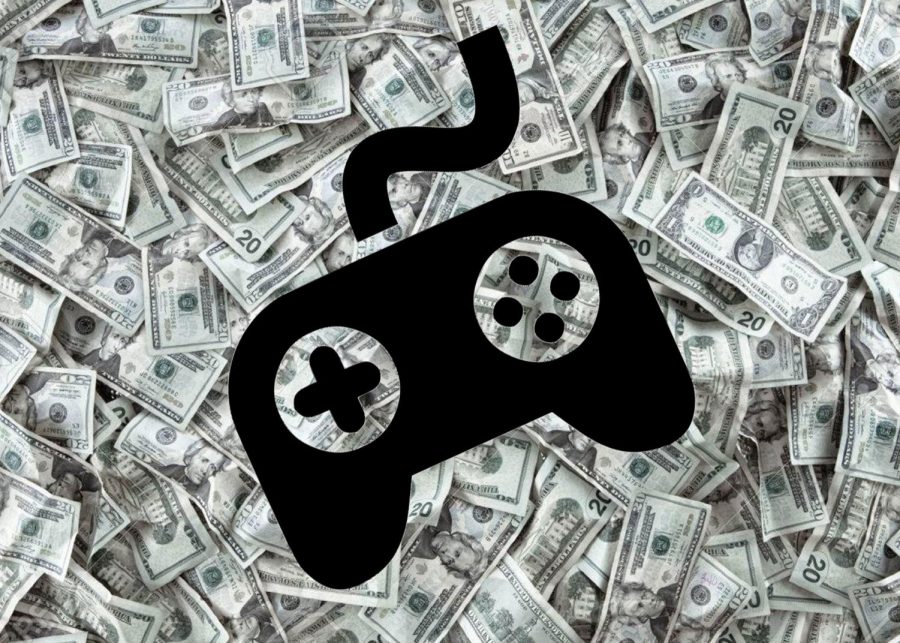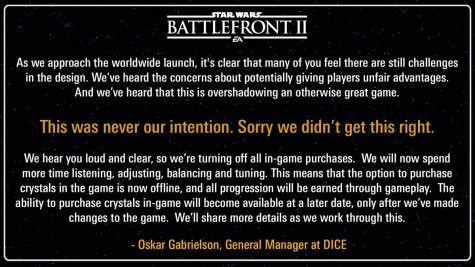What’s Wrong with Microtransactions in Video Games?
October 13, 2021
For those who are new to gaming, microtransactions is the system of buying a digital item for a video game either being a benefit for being better at the game, or simply to make your in-game characters look better. Cosmetics, pay to win features, and loot boxes have been a source of contention for gamers for the past few years.
Gamers have been spending hundreds of dollars a month just for in-game cosmetics, rarity in game items, and pay-to-win features. An average gamer spends about $92 on microtransactions. Many video game companies such as DICE, EA, and Valve have had controversies over microtransactions. Here’s a look at some of the most prominent cases of microtransaction controversies.
Star Wars Battlefront II’s Failed Launch
On November 17, 2017, Electronic Arts released “Star Wars Battlefront II”. Upon release, players noticed that they could spend over $2,000 to receive every item, cosmetic, star card, and every character. The player base immediately dropped when this was discovered. Electronic Arts removed all microtransactions from the game and all cards, characters, etc. have to be earned from in-game loot boxes, or by spending an in-game currency. As of today, the player base is still very low and people still mock EA to this day.
The Culling: The Worst “Pay to Play” Feature Ever
Back in 2017, a game called “The Culling” became a very popular battle royal game. The game became so popular that the developers at Xaviant randomly announced a sequel to the game, The Culling II. Gamers criticized this game for being an “unfinished cash grab”. The Culling only had 250 players online max, and only 8 matches were played. After 40 hours of the game’s release, there wasn’t a single player playing the game. The developers tried to revive their franchise by making another Culling game. This time it was a prequel to the other Culling games. The Culling Origins was released on May 14, 2020 and implemented the worst “pay to play” feature ever. Players were only allowed to play one free match every 24 hours, and if a player wanted to play more than one, they would have to buy a match. Gamers quickly criticized the game as being a good game but with terrible, greedy, developers. There was so much backlash that the developers allied 10 free matches a day, rather than one. This still did not fix the greedy problem.
The TF2 and CSGO Loot Box System
Some games offer microtransactions usually to make the player better at the game, but some companies offer cosmetic items to make the player look better. Cosmetic items provide no advantage to gameplay, but instead make things like player models, and weapons colorful and noticeable. In Team Fortress 2, cosmetics are extremely common and noticeable. The system was used so much to where the genre of the game changed from a team based first person shooter to a “war themed hat simulator”. In another game called “Counter Strike Global Offensive”, players have been gambling with the loot box system and with other gambling sites. These gambling sites, also known as “Skin Betting” are places where you can purchase a skin for a minimum of $2.49, there is a chance where the player can receive a rare and a high value skin, or something less valuable. A popular gambling site known as “The CSGOLotto” were usually streamed and promoted on YouTube or twitch channels. This led to a controversy and 2 class action lawsuits, claiming that this is real gambling and that underaged players have been getting involved with the system. The company behind CSGO, Valve, has issued 23 cease and desist orders to finally shut down any CSGO gambling sites.
In Team Fortress 2, hats and cosmetics have not really been a problem, but players are spending millions of dollars on a piece of texture that someone else made. Players really start to spend their money when they try to get that “rare item” that no one else has. It gives that feeling of adrenaline, like winning a triple 7 on a slot machine. A player would almost instantly like an item because it was simply rare, it won’t really matter if it’s cosmetic or an advantage.
Mobile Games
Mobile games have been taking off since the early 2000’s with the introduction of mobile phones. Everyone remembers the classic and the best mobile games like, “Angry Birds” and “Jetpack Joyride” being fun and very entertaining. However, the mobile games everyone has now are poorly made cash grabs that are meant to be good for less than a few hours. Some mobile games are just littered with microtransactions, while other games are not entirely full of microtransactions but instead use ad revenue. Ad revenue works when developers of shows or games allow ad publishers to display their ads in their product. Therefore they’re paid for each ad that is displayed. Most games, like “Tiny Tower”, use an “Ad for reward” system where the player can choose to watch an ad for a small in-game reward. However, most games do not allow this. Instead, ads are displayed almost 100% of the time. Most players will turn off their Wi-Fi and their cellular service just to block the ads for free.
With the introduction of microtransactions, most game developers have fallen into greed and implemented ridiculous ways to make money off of their games. Most gamers are realizing that this idea of microtransaction is going too far and making games unplayable, pay to play, cash grabs.





